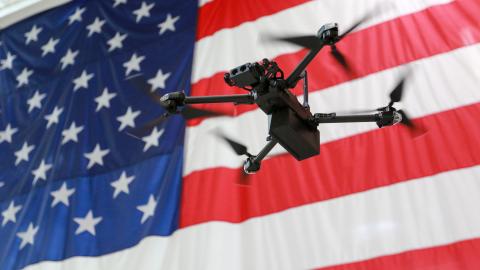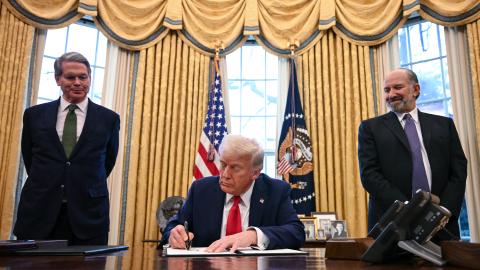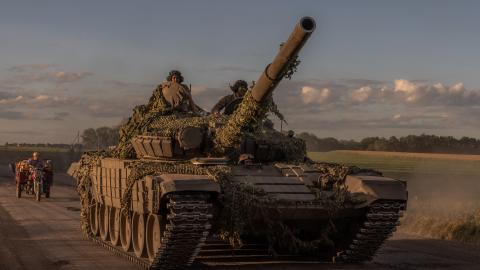Below Senior Fellow Can Kasapoğlu offers a military situation report about the war in Ukraine.
Executive Summary
• The Ukrainian military launched a surprise offensive inside Russia, making significant gains in Kursk Oblast.
• Detachments from multiple Ukrainian brigades, as well as a special drone warfare regiment and the Georgian Legion, have taken part in the daring attack.
• The Kremlin has declared a federal emergency, but Russia’s response has been disorganized and thus far unable to halt Ukraine’s push.
• Russian forces in Ukraine continue to press their advantage, particularly in Pokrovsk, where Ukraine’s lines of defense face mounting difficulties.
1. Ukraine Launches a Massive Operation in Russia
On August 6, the Ukrainian Armed Forces dispatched a combined arms invasion force into Kursk Oblast in Russia. This unexpected offensive, augmented by fighters from the Georgian Legion, involved detachments from multiple air-assault and mechanized Ukrainian brigades.
Ukraine’s incursion began with heavy first-person-view (FPV) drone salvos and electronic warfare attacks. The 14th Regiment of the Ukrainian Unmanned Systems Command, which specializes in robotic systems and emerging defense technologies, has led Kyiv’s drone warfare activities. Visual open-source intelligence (OSINT) suggests that Ukrainian drones downed a Russian Mi-28 helicopter, a significant milestone in drone warfare.
Unlike Ukraine’s previous raids into Russia, the campaign in Kursk is a conventional warfare effort. This marks a significant shift in the Ukrainian military’s approach to operations beyond its borders. Initial indicators, such as Kyiv’s use of heavy armor from the outset of the offensive, suggest that Ukraine intends for its forces to remain in Russian territory until the end of the war. As of the campaign’s fifth day, Kyiv controlled around 400 square miles of Russian territory. Experts suggest that Ukraine has deployed up to 10,000 troops and 600 warfighting vehicles in and around the region.
Meanwhile, the Kremlin has declared a federal emergency and is trying to rush personnel into the combat zone. Social media sources suggest that detachments from the Wagner private military company commanded by Alexander Kuznetsov, one of the group’s founders, are also rushing to defend Kursk. Recently, Kuznetsov, who uses the call sign Ratibor, secured a deal with pro-Russian Chechen strongman Ramzan Kadyrov to operate alongside Kadyrov’s Akhmat special forces group, which has also been deployed to the area.
The Kremlin has been slow to react to mushrooming security problems inside Russia’s borders since last year’s failed Wagner putsch, when the private army took control of the Southern Military District in Rostov-on-Don and marched to the outskirts of Moscow within 24 hours. The Ukrainian incursion into Kursk has taken advantage of this critical vulnerability. Therefore the Russian military’s response to Ukraine’s offensive will be very instructive for the next phase of the war. The areas in Ukraine from which Moscow pulls troops to defend Kursk are likely to see some relief from Russian offensive actions.
Several additional considerations will decide the trajectory of Ukraine’s offensive. Much will depend on Kyiv’s ability to bring additional troops and equipment into Kursk to establish second- and third-echeloned defenses in the areas it has captured. In this effort, Ukraine would benefit greatly from anti-tank weapons to prey on heavy armor, a strong drone warfare deterrent to establish robust reconnaissance strike capabilities, and an intense artillery presence. Ukrainian engineering formations should quickly establish a defensive architecture to defend captured territory from forthcoming Russian counteroffensives.
Moreover, Ukraine should bring artillery and rocket systems to Kursk to target Russian reinforcements with deep strikes. Open-source intelligence suggests that the Ukrainian military has used its High Mobility Artillery Rocket Systems (HIMARS) to pound Russian convoys. As of August 11, Ukrainian positions are a mere 20 miles from the E38 Highway, an essential support route for the Russian military’s defensive combat operations in Kursk.
Units like the 80th Air Assault Brigade, which is responsible for conducting blitz penetration and maneuver warfare to outflank Russian defensive positions, should also take care not to outrun their surface-to-air missile (SAM) protection lest they expose themselves to Russian counteroffensive action. Maintaining this delicate balance requires almost flawless coordination at the operational level.
The task Ukraine needs to accomplish—keeping its combat formations protected under a robust air defense umbrella—is not dissimilar to the challenge Egypt faced in the opening days of the 1973 Yom Kippur War. To meet this challenge, Kyiv should move its layered SAM systems, including its Patriot and National Advanced Surface-to-Air Missiles (NASAMS), into the area of operations. This would enable Ukraine to preventively hit the Russian Aerospace Forces (VKS), a concept to which some writers have applied the pun “SAMbush.” However, this would require Ukraine’s Western partners to lift restrictions on the use of Western-supplied weapons. Moreover, the Ukrainian units penetrating Kursk will need organic air defenses to accompany their air assault and mechanized infantry efforts.
While Russian Telegram channels confirmed that Ukrainian man-portable air defense systems (MANPADS) downed a Russian Ka-52 gunship, visual intelligence suggests that both Ukrainian and Russian combat formations are now scattered across Kursk Oblast. With each side bringing in reinforcements, some Ukrainian units will soon find themselves fighting deeper inside Russia.
The latest OSINT shows that the city of Sudzha, which the Ukrainian military now mostly controls, is one of the primary objectives of the offensive. Sudzha is a critical hub for the Russian railway network. Capturing the city would help Ukraine significantly disrupt Russian logistics operations.
Moreover, the Ukrainian push has sparked a massive displacement of civilians within Russia. Tens of thousands of Russians are fleeing the Kursk region. Our monitoring of the situation suggests that this has already caused bottlenecks along the railways that are the main veins of Vladimir Putin’s combat formations.
At present, Ukrainian progress is culminating and reaching the Kursk Nuclear Power Plant might be an overly ambitious aim. Nonetheless, Ukraine’s gains thus far would give Kyiv considerable diplomatic leverage if it can hold them.
2. Battlefield Assessment
Positional fighting in Ukraine continued last week at a highly attritional tempo, as Russia continued to amass steady territorial gains. According to official Ukrainian reports, clashes continued on 10 fronts, highlighting the sprawling nature of the conflict. OSINT suggests that the fiercest clashes occurred on the Pokrovsk front.
Elsewhere, Russia registered alarming gains in Niu-York, Toretsk, and Chasiv Yar. According to some battlefield reports, Russian forces progressed between 1,600 and 3,200 feet per day in western Niu-York over the past week. Recent geospatial evidence indicates that Russian units are also advancing in Serhiivka. Along the axis approaching Pokrovsk, Ukraine’s lines of defense reportedly crumbled due to a lack of personnel, rendering the still-evolving situation critical. Ammunition shortages and a limited pool of fighters continue to trouble the Ukrainian military.
Despite lingering constraints in its ability to prosecute ground operations, Ukraine continued strategic long-range strikes on critical targets inside Russia. Last week, Ukrainian forces struck Lipetsk Air Base with dozens of kamikaze drones. Located 190 miles from the Ukrainian border, the air base hosts several important Russian platforms, including Su-34 and Su-35 fighter-bombers.
Last week also witnessed exciting developments in drone- and robotics-driven concepts of operations (CONOPS). Visual evidence suggests that Ukrainian FPV drone operators successfully hit and crashed a Mi-28 Havoc anti-armor attack helicopter over Russia’s Kursk Oblast. This is the second instance in recent months of an unmanned aerial vehicle (UAV) taking down a helicopter, hinting at FPV drones’ expanding role in aerial warfare. Ukrainian FPV drones are also serving in logistical roles. Visual evidence from the battlefield shows that the 53rd Mechanized Brigade uses FPVs to deliver water, food, and ammunition to servicemen on the frontlines.
Finally, social media reports suggest that Tehran is preparing to train Russian troops in Iran and deliver Moscow hundreds of ballistic missiles, including Fath-360 solid-fuel, short-range tactical ballistic missiles. First tested last year, the Fath-360 possesses a 330-pound warhead and a maximum range of 75 miles.

















